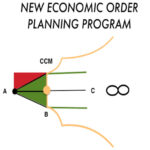 The Economics of Life economic education programs were created from findings of the Doctors Economic Research Project and the Economics of Life Research Project that indicated that doctors, business executives, business owners, and other highly productive individuals had little or no access to effective, understandable, economic education regarding the earnings management and savings management planning that was required to achieve financial independence, and no access to guaranteed outcome planning.
The Economics of Life economic education programs were created from findings of the Doctors Economic Research Project and the Economics of Life Research Project that indicated that doctors, business executives, business owners, and other highly productive individuals had little or no access to effective, understandable, economic education regarding the earnings management and savings management planning that was required to achieve financial independence, and no access to guaranteed outcome planning.
Attendees at Economics of Life seminars were asked two questions: 1. What do you need to KNOW to succeed financially? and 2. What do need to HAVE to succeed financially? Answers to these two questions that were provided by seminar attendees led to the development of planning models that illustrated the planning needs of productive individuals in the context of their personal economic life cycles.
The economic education program defined a productive individual’s financial objectives as financial independence and personal significance. Financial independence was defined as an accumulation of guaranteed life income that equaled lifestyle costs. The achievement of the financial independence goal was demonstrated to be dependent on productive individuals’ career capabilities to generate earnings that exceeded lifestyle costs and to save those surplus earnings, without losses to unnecessary income taxes, and then to convert these savings to taxable and tax-free guaranteed life income that would fund their lifestyle costs through life expectancy.
The planning models were utilized to develop personalized capital accumulation, capital distribution, and endowment creation planning programs for doctors, business owners and executives, and other highly productive individuals.
The Economics of Life economic education program presented findings developed from data that was collected on approximately 250,000 doctors and other productive individuals who attended the Economics of Life seminars over a thirty-year period. The economic education program also presented findings that were developed from data gathered from the 65,000 participants in the evidence-based capital accumulation and capital distribution planning programs that had been developed from the research projects.
The advent of the Great Recession in 2007 irrevocably changed the economics of life for productive Americans and initiated a new era for the economic research projects and the Economics of Life Education Program. The New Economic Order Economics of Life Education Program has been initiated with a series of seminars and on-line economic education resources that are now available to doctors, business owners and executives, affluent individuals, and other productive individuals through memberships in the New Economic Order Planning Association (non-health professionals) and the Doctors Economic Research Association (physicians and dentists).